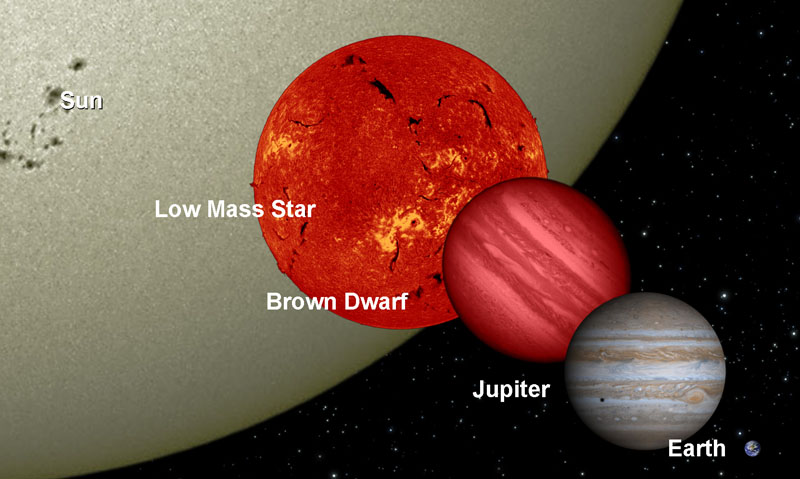Jupiter, a planet almost as wide as a small star, is hard to miss even in the vastness of space - if you know just a lttle astronomy it shines like a beacon in our skies. Even its system of moons and rings is structured more like a miniature solar system than a... well... system of moon's and rings. It's a vast planet, and it influences a vast region of space
 |
Above: How Jupiter compares to the smallest stars.
Some people are prejudiced about this sort of thing, but I like 'em big. |
So Jupiter has been a major target for probes and space telescopes - the JUNO space probe is there right now, returning some astounding images and unprecedented results. So let's say we could have ridden with Juno to the Jupiter system, then gone our own way to have a poke around the giant planet's territory. What are the Jovian equivilents of Niagra falls and Everest?
1: The Great Red Spot
 |
| Image by NASA/JPL, processing by Jason Major. |
According
to Donald Trump, a man of... questionable... judgement, global warming is 'just weather'. But even he would
struggle to shrug off Jupiter's Great Red Spot: This
storm is big enough to swallow several planet Earths, and draws it's
power from deep within the giant planet. No-one knows for sure why the
upper layers of clouds are red, although a lot of explanations have been
put forward. Other storms that have grown enough to reach a comparable
size have also turned red, so whatever it is is common to all of
Jupiter, not just the one super storm.
Just
recently the JUNO space probe flew closer to it than any spacehip ever
before, sending back astounding images like the one above - you can see more, here.
2: Gigantic aurora
Earth's aurora
are the result of solar weather interacting with its magnetic field. So,
given that Jupiter's magnetic field is so huge it would be as big s the
Moon when seen from Earth (if it were visible),
it's not surprising that Jupiter's aurora are pretty damn spectacular.
In fact, they're hundreds of times stronger, and on top of that they're
both non stop and several times bigger than our whole Earth.
3: The swirling chaos of Jupiter's north pole.
One of the sights JUNO has revealed is the chaotic, complex, systems of storms that occupy Jupiter's north pole. Like no mission before, this ne is revealing Jupite itself in all its inhuman glory, and you can see all the images here.But the blue tinged north pole, a region many times larger than Earth, has been the most unexpected: It lacks the ordered cloud stripes and wind bands of the rest of the planet. Instead, immense storm systems churn endlessly against each other, giving patterns more reminiscent of something from an H.P. Lovecraft novel.
4: Io
In my opinion astronomers project emotions onto titanic
cosmic things a bit much: A supernova does not have a 'fury', guys, it's an exploding star - it doesn't need fury!
And
of course, I never do that myself... ahem.
5: Europa
If Io shines in Jupiter's sky like a spirit of vengance, it's sister moon Europa is the spirit of serenity: The same forces that have turned Io into a volcanic hell scape have warmed the core of the icy moon Europa, melting the lower levels of ice into an ocean more immense than anything found on Earth: Spanning the whole moon, and up to 100 km deep, this ice covered deep is where Poseidon would truly belong.
6: Titanic comet strikes
 |
| Above: The fragments of comet Shoemaker-Levey 9 |
Decades
back a comet, named Shoemaker-Levy 9, was torn apart by the gravity of
Jupiter. The debris left behind took the form of a long string of
comets, and on the next orbit that string smashed into the giant plant,
each fragment smashing into the atmosphere one at a time. At the time we
thought this was a unique event, but astronomers are beginning to suspect
that gigantic asteroid strikes on Jupiter are more common than we realised, thanks to it's gigantic gravity.
That's the whistle stop tour of Jupiter. But will ordinary people one day get to see these things frst hand? What do you think?
...or, if you'd like to help us do things like podcasts, animations, and videos here why not...























